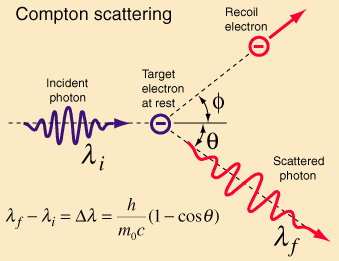-
 Lagrangian
Lagrangian
-
 Malate
Malate
-
 Absolute density
Absolute density
-
 Generalised epilepsy
Generalised epilepsy
-
 Pigmented
Pigmented
-
 Photino
Photino
-
 Self-signed key
Self-signed key
-
 Velociraptor
Velociraptor
-
 Phases of the Moon
Phases of the Moon
-
 Omega-9
Omega-9
-
 LLC
LLC
-
 Homozygote
Homozygote
-
 Endoderm
Endoderm
-
 Coanda effect
Coanda effect
-
 Urban heat island
Urban heat island
-
 Genetic Engineering
Genetic Engineering
-
 Mordanting
Mordanting
-
 Canadarm
Canadarm
-
 Hour circle of a direction
Hour circle of a direction
-
 FAO
FAO
-
 PP Live
PP Live
-
 Triglycerides
Triglycerides
-
 GLONASS
GLONASS
-
 Penicillin
Penicillin
-
 Coppice
Coppice
-
 Dextrorotatory
Dextrorotatory
-
 Tiagabine
Tiagabine
-
 Xylene
Xylene
-
 Message digest
Message digest
-
 Ebola Virus
Ebola Virus
Compton scattering
The Compton effect is a well known phenomenon discovered in 1923 by the Nobel physics prize winner Arthur Compton showing that light is made up of quanta of energy having momentum. The effect occurs on the collision of an energetic photon, such as an X-ray photon, with a particle of matter, such as an electron, considered to be at rest.
The Nobel physics prize winner Arthur Compton. © The Nobel Foundation
This collision is accompanied by a change in wavelength of the photon after the collision which is very similar to a collision between two particles. When the photon has a longer wavelength following the collision, i.e. it has lost energy to the electron, Compton scattering has occurred.
When the wavelength of the photon is shorter and therefore the photon has gained energy from the electron, inverse Compton scattering has occurred. This is a particularly important effect in astrophysics and cosmology since it explains the Sunyæv-Zel'dovich effect.
 A diagram illustrating Compton scattering, i.e. the scattering of a photon following collision with a particle, here an electron. The formula gives the final photon wavelength as a function of its initial wavelength and the scattering angle theta. © Robert Hart
A diagram illustrating Compton scattering, i.e. the scattering of a photon following collision with a particle, here an electron. The formula gives the final photon wavelength as a function of its initial wavelength and the scattering angle theta. © Robert Hart
Latest
Fill out my online form.




